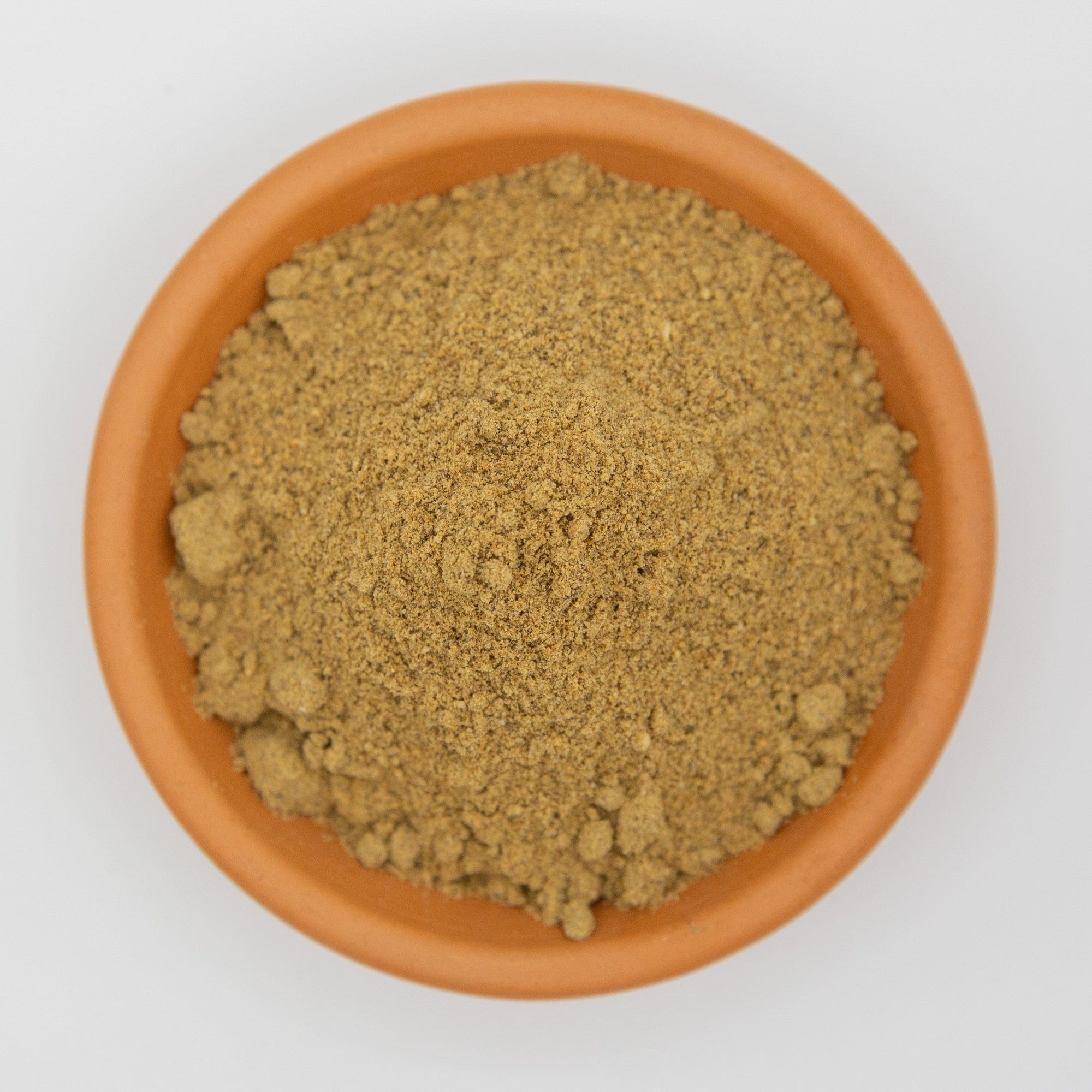Fish & Bone meal is processed from sustainable caught marine fish, making it a good source of organic phosphorus and calcium along with nitrogen and other micronutrients.
N:8%, P:8%, K:1%, S:0.8%, Ca:13% plus Amino Acids and Vitamins
Fish & Bone meal is well suited for your lawn and garden, fruit trees and broad acres. Fish ’N’ Bone contains approximately 45% protein and rest all marine bone with high calcium which can be naturally broken down into plant available nitrogen, phosphorus and calcium. The protein content equates to about 8% nitrogen, bone values upto 8% and 12% phosphorus and calcium respectively.
Fish & Bone meal is high in both macro and micronutrients as well as contains many essential amino acids and vitamins, which is a good source of food for soil bacteria and fungi.
For an effective results, it is better if you can apply in Autumn, Winter and Mid Spring as Fish & Bone meal will release the Nutrients very slowly with out allowing them to leach or waste. There fore Fish & Bone meal applied plants looks always healthy.
The product can be safely used while planting/transplanting or repotting as the product will not burn the roots.
Usage Information: Use at 1-2 cups per square meter, or 1/4-1/2 cup per 30L of potting soil.
Other advantages:
- Contains a very wide variety of vital elements, such as amino acids, calcium, phosphorus, and nitrogen which are all fish derived!
- Fish & Bone meal increases soil health and fertility by incorporating the necessary nutrients and encouraging the development of advantageous microbes.
- It can be utilized to increase plant yields and overall vigor.
- Can be utilized as a natural source of nutrients with a delayed release.
- Is a perfect addition to compost teas!
- Will aid in increasing aeration, water retention, and soil structure by activating soil microbes and earthworm activity.

FAQs:
What is Fish & Bone Meal and what’s in it?
A natural fertiliser made from sustainably caught marine fish frames and bones, supplying approximately NPK 8-8-1 with ~13% calcium plus amino acids, vitamins and trace minerals.
What does Fish & Bone Meal actually do for plants?
It feeds strong roots, flowers and fruit thanks to slow-release phosphorus and calcium, while the amino acids and organic nitrogen support steady vegetative growth and soil biology.
Is Fish & Bone Meal safe to use at planting time—will it burn roots?
Yep—mixing it into the backfill when planting or repotting is fine. It’s gentle, slow-release and won’t scorch roots when used as directed.
When should I apply Fish & Bone Meal for best results?
Autumn, winter and mid-spring are ideal because the nutrients release slowly over cool/wet months. You can also add a light dose when transplanting or prepping beds.
How much should I use?
As a soil amendment: 1–2 cups per square metre. For potting mixes: ¼–½ cup per 30 L of potting soil. Work it into the top 5–10 cm of soil and water in.
Can I top-dress existing plants?
Yes. Scratch a light sprinkle into the topsoil (don’t leave it sitting on the surface), then water. Mulch over the top if pets or wildlife are curious.
What plants benefit most?
Bulbs, fruiting veg (tomatoes, chillies, capsicum), flowering perennials, fruit trees, lawns establishing from seed/turf, and any crop needing a phosphorus/calcium nudge.
Is Fish & Bone Meal okay for native or phosphorus-sensitive plants (e.g., some Proteaceae)?
Usually avoid for P-sensitive natives. For natives, use very small amounts—if at all—or choose a low-P native fertiliser.
Does soil pH matter?
Yes. Phosphorus from bone/fish sources is more available in slightly acidic to neutral soils (roughly pH 6.0–7.0). In alkaline soils (pH >7), it becomes less available.
Can I use Fish & Bone Meal in hydroponics or reservoirs?
No. It’s not water-soluble and will create sludge/odour in tanks. It’s meant for soil and soil-like mixes.
Does Fish & Bone Meal smell? Will it attract pests or pets?
It has a mild, “fishy/organic” scent that fades after watering in. Dogs and wildlife may dig where it’s applied—mix it into the soil and cover with mulch to deter them.
Is Fish & Bone Meal suitable for compost or compost teas?
A little goes a long way. Add sparingly to compost to boost P and Ca. It can be used in compost teas in small amounts, but solids should be well-contained/filtered.
How long does Fish & Bone Meal last in the soil?
It’s slow-release. Expect benefits over several months, with residual effects as soil microbes continue to break it down.
Can I combine Fish & Bone Meal with other amendments?
Yes. Pair with balanced organics like kelp, worm castings or quality compost for a broader nutrient spectrum. If you add high-N inputs (e.g., blood meal), use modest rates to avoid overdoing nitrogen.
Will Fish & Bone Meal fix blossom end rot on tomatoes and capsicums?
It helps prevent calcium-related issues over time by supplying Ca and improving overall nutrition. For active symptoms, also maintain even watering and avoid excessive nitrogen.
Is Fish & Bone Meal certified organic?
It’s an organic input made from fish bones/frames. If you require a certification logo for a specific program, check the product label/batch directly or contact Dr Greenthumbs support.
Is Fish & Bone Meal vegan-friendly?
No. It’s derived from fish.
What’s the difference between Fish & Bone Meal and regular Bone Meal?
Fish & Bone typically carries similar phosphorus and calcium to standard bone meal but includes more organic nitrogen and amino acids from the fish protein, giving a slightly broader nutrient profile.
How does Fish & Bone Meal compare to rock phosphate?
Rock phosphate can be slower and less available in many soils. Fish & Bone is biologically processed and tends to integrate faster in living soils, especially with good microbial activity.
Can Fish & Bone Meal cause nutrient lockout or imbalances?
Over-application of any P source can build up phosphorus and reduce mycorrhizal activity. Stick to the recommended rates and do an occasional soil test if you fertilise regularly.
Any tips to reduce fungus gnats or flies when using organic meals?
Mix it in (don’t leave it on the surface), water it in, and cover with a thin mulch layer. Good drainage and airflow also help keep gnats down.
Is Fish & Bone Meal safe around pets and kids?
Use common-sense precautions: store sealed, apply below the surface, water in, and keep pets out of freshly treated areas until odour dissipates. If a pet consumes a large amount, contact a vet.
Will Fish & Bone Meal stain patios or smell indoors?
It can mark porous surfaces—apply over soil/garden beds only. For indoor plants, mix into the potting mix and water in; avoid getting product on hard floors.
How should I store Fish & Bone Meal and what’s the shelf life?
Keep it cool, dry, sealed and out of direct sun. Properly stored, it remains effective for years, though aroma can fade and fine particles may clump—just break them up before use.
Can I use Fish & Bone Meal on lawns?
Yes—great for establishment or renovation. Rake 1–2 cups/m² into the top few centimetres of soil before seeding/turfing. For existing turf, apply lightly, then water deeply.
What about container plants?
Blend ¼–½ cup per 30 L of potting mix, or top-dress lightly every 6–8 weeks during active growth, then water in.
Is Fish & Bone Meal okay to use right before heavy rain?
Better to apply when you can water in gently and avoid immediate downpours—this reduces surface odour and the chance of runoff.
Can I use Fish & Bone Meal with mycorrhizal inoculants?
Absolutely. Mycorrhizae help plants access phosphorus; combining them with Fish & Bone Meal is a smart, soil-first strategy.
Does Fish & Bone Meal change soil structure?
Indirectly—by feeding microbes and earthworms, which improves aggregation, aeration and water retention over time.
Any red flags that I’ve used too much?
Persistent surface smell, pets obsessively digging, algae growth in runoff, or plants showing dark green foliage with poor flowering. If you see any of these, pause additional feeding and reassess rates.
Quick recipe for a new bed?
Per square metre: 1–2 cups Fish & Bone Meal + quality compost + a handful of kelp meal. Fork in, water, then mulch. Plant after the soil settles (24–48 hours).



